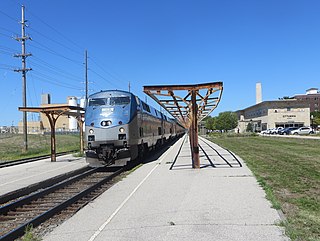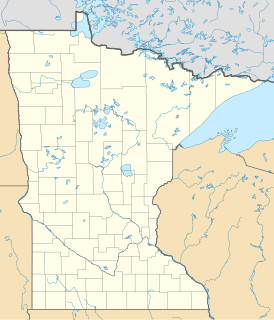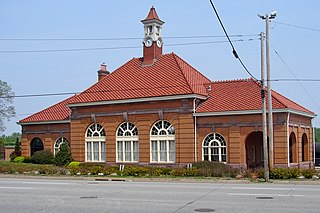
The Chicago, Milwaukee, St. Paul and Pacific Depot Freight House and Train Shed, now officially named The Depot, is a historic railroad depot in downtown Minneapolis, Minnesota. At its peak, the station served 29 trains per day. Following decline, the station was closed and eventually adapted into various other uses.

Ottumwa is an Amtrak intercity train station in Ottumwa, Iowa, United States. The station was originally built by the Chicago, Burlington and Quincy Railroad, and has been listed as Burlington Depot by the National Register of Historic Places since November 26, 2008. It became a contributing property in the Historic Railroad District in 2011.

The Como Roundhouse, Railroad Depot and Hotel Complex is a collection of historic buildings in Como, Colorado.

The Gallatin Gateway Inn is a Spanish-stucco style railroad hotel at Gallatin Gateway, Montana. The hotel is one of the "Historic Inns of America." The Gallatin Gateway Inn was opened on June 18, 1927. Constructed and operated by The Milwaukee Road, the luxury hotel was reached by electrified railroad branch line that connected to the Milwaukee's main line at Three Forks, Montana. It was among the first hotels in Montana with telephones in every room, and offered travelers access to Yellowstone National Park. Park buses took passengers from the hotel to the park.

The Chicago, Milwaukee, St. Paul and Pacific Railroad Depot and Lunchroom are two buildings located in Wells, Minnesota, and built by the Chicago, Milwaukee, St. Paul and Pacific Railroad in 1903.

Chicago, Milwaukee, St. Paul and Pacific Depot – Delmar is a historic building located in Delmar, Iowa, United States. It is listed on the National Register of Historic Places.

The Chicago, Milwaukee and Pacific Railroad-Albert City Station, also known as the Albert City Depot, was built by the Chicago, Milwaukee, St. Paul and Pacific Railroad in 1899 to serve the farms around Albert City, Iowa. The railroad built the line from Des Moines to Spencer, Iowa, in 1899 to serve local agriculture. Albert City was platted the same year. The depot was built for passenger service as well as freight.

The Chicago, Milwaukee, St. Paul and Pacific Freight House, known locally as The Freight House, is a historic building in Downtown Davenport, Iowa, United States. It was listed on the National Register of Historic Places in 1985.

The Chicago, Rock Island and Pacific Railroad Passenger Station is a historic building located in Iowa City, Iowa, United States. Built in 1898 for passenger use, it was the second depot in the city. The first one was built by the Mississippi and Missouri Railroad, a predecessor of the Chicago, Rock Island and Pacific Railroad (CRI&P), in 1855. This one was built through the efforts of Harry Breene, the local Rock Island agent. W.K. McFarlin, CRI&P's superintendent of maintenance and construction oversaw the building's construction. Architecturally, it is a combination of the Richardsonian Romanesque and Victorian Romanesque. The depot was built to similar designs of stations in Ottawa, Illinois, and Council Bluffs, Iowa. Service included the CRI&P's Corn Belt Rocket and Rocky Mountain Rocket passenger lines. The depot ceased operations in 1970, although the railroad continued to maintain offices here. In 1982 it was acquired by a couple of attorneys for their offices. It was listed on the National Register of Historic Places the same year. The building sits adjacent to the Iowa Interstate Railroad lines, and the railroad has operated occasional excursion trains that have stopped at the former depot.

Union Station, also known as Union Station and Burlington Freight House, is located near the riverfront in downtown Davenport, Iowa, United States. It is listed on the National Register of Historic Places. The buildings are in a section of downtown with several historic structures. Across Ripley Street to the west is the Chicago, Milwaukee, St. Paul and Pacific Freight House, and to the east across Harrison Street is the Dillon Memorial. On River Drive northwest from the Burlington Freight House is The Linograph Company Building. Across Beiderbecke Drive to the south are the W.D. Petersen Memorial Music Pavilion and the Mississippi River.

The Burtis–Kimball House Hotel and the Burtis Opera House were located in downtown Davenport, Iowa, United States. The hotel was listed on the National Register of Historic Places in 1979. It has since been torn down and it was delisted from the National Register in 2008. The theatre building has been significantly altered since a fire in the 1920s. Both, however, remain important to the history of the city of Davenport.

The Rock Island Lines Passenger Station, also known as Abbey Station, is an historic building located in Rock Island, Illinois, United States. It ceased operating as a railway station in 1980. The building was listed on the National Register of Historic Places in 1982, and it was designated a Rock Island landmark in 1987.

City Hotel, also known as Seifert's Tavern and the Wheatland Feed Mill, on 214 South Main Street in Wheatland, Iowa was listed on the National Register of Historic Places for Clinton County, Iowa in 2007.

The Sexton Hotel, also known as Hotel Stuart, is a historical building located in Stuart, Iowa, United States. The building is a two-story, L-shaped, brick and brick veneer structure that was built in two parts. The oldest section was a frame building built by John Sexton in 1893 and housed a restaurant. It was moved to the north and the brick hotel wing was built by Sexton in 1907. The older structure, now the north wing of the larger building, was covered with brick veneer. The primary entry into the hotel is located in the canted entrance bay on the southwest corner of the building. There were 28 guest rooms, and the first floor of the north wing housed the dining hall. The first floor also housed a large lobby, the owners quarters, and some of the guest rooms.

The Chicago, Milwaukee & St. Paul Depot-Jefferson, also known simply as the Milwaukee Depot is an historic building located in Jefferson, Iowa, United States. The rail line that this station served was built by the Wabash, St. Louis & Pacific Railroad in either 1882 or 1883. It was part of the 500 miles (800 km) of track developed by Jay Gould in Iowa. Known as the High Bridge Route because of the height of the bridge over the Des Moines River, it was acquired by the Des Moines, Northern and Western Railroad in 1891. Four years later the Chicago, Milwaukee and St. Paul Railroad acquired the line. The Milwaukee Road built this train station from their standard building plan between 1906 and 1909. It is almost identical to the station built in 1906 in Adel, Iowa. This passenger station replaced a combination passenger and freight depot that was moved and used solely as a freight depot. The Milwaukee Road discontinued passenger service in Jefferson in the early 1950s, and the depot continued as a freight office until 1980. The building was listed on the National Register of Historic Places in 1994.

The Chicago, Milwaukee & St. Paul Narrow Gauge Depot-LaMotte is a historic building formerly located in La Motte, Iowa, United States. The Chicago, Bellevue, Cascade & Western Railroad was incorporated in August 1877, to build a narrow-gauge railway from Bellevue to Cascade. Narrow-gauge was chosen because it was cheaper to build, and it could negotiate the tight turns on the rugged terrain better. Construction began the following year, but lack of money doomed the project. The Chicago, Clinton, Dubuque and Minnesota Railroad took over the project, and it was completed on December 30, 1879. The first train reached Cascade on January 1, 1880. Ten months later they sold all their holdings to the Chicago, Milwaukee & St. Paul Railroad, and this line became a branch line of the Milwaukee Road. That same year a frame depot was built in La Motte. It served as a combination freight and passenger station until it was destroyed by fire in 1910. This depot replaced it the following year. The 1½-story frame combination station represents the corporate style and standardized practices of the Milwaukee Road. However, it reflects the depots they built in the late 19th century, so it was somewhat outdated when it was built.

The Calmar Passenger Depot is a historic building located in Calmar, Iowa, United States. It was built by the Chicago, Milwaukee & St. Paul Railroad in 1915 to replace the Depot Hotel that had been destroyed in a fire. The single-story building originally featured a 27 feet (8 m) canopy on its east side that was removed by the railroad in 1970. It was reconstructed in 1998. The passenger trains were on a line that ran between Madison, Wisconsin and South Dakota. They were discontinued in the 1960s. The former depot now houses restrooms for the Prairie Farmer Bike trail, which is adjacent to the building, farmers and flea markets, and other small community events. It was listed on the National Register of Historic Places in 2011.

The Chicago, Milwaukee, St. Paul & Pacific Combination Depot-Hornick, also known as the Hornick Depot, is a historic building located in Hornick, Iowa, United States. The town was patted by the Chicago, Milwaukee, St. Paul & Pacific Railroad's land company when the railroad created a branch line from Manilla, Iowa to Sioux City. Completed in 1887, the railroad built this two-story frame structure to serve as its passenger and freight depot. It is one of six such depots that remain in Iowa, and the best preserved. These buildings were built from a standard design used by the railroad. The two-story stations included living quarters for the station manager because the towns had yet to develop when the depot was built. This was an island depot, with freight loaded on the north side and passengers boarded on the south. Decorative elements on this depot include lathe-turned wooden finials, angled wooden brackets, and bracketed door and window hoods. Passenger service ended in the 1950s, and grain was loaded here until 1980 when the Milwaukee Road abandoned the Sioux City branch line. The building was listed on the National Register of Historic Places in 1990. It has been converted into a local history museum.

The Marion Commercial Historic District is a nationally recognized historic district located in Marion, Iowa, United States. It was listed on the National Register of Historic Places in 2009. At the time of its nomination it consisted of 41 resources, which included 29 contributing buildings, one contributing site, one contributing structure, two contributing objects, and eight non-contributing buildings. The historic district covers the city's central business district. The development of this area largely occurred when Marion was the county seat of Linn County (1838-1919). There are no county government buildings extant from this era. The city was also a division point for the Chicago, Milwaukee, St. Paul and Pacific Railroad in the late nineteenth and early twentieth centuries.

Marion station was a railroad station in Marion, Iowa. It served passenger trains of the Chicago, Milwaukee, St. Paul and Pacific Railroad, commonly known as the Milwaukee Road. After passenger train service was discontinued, elements of the station were moved across the street to City Square Park, where it remains as a pavilion today. The structure is listed as a non-contributing property by the National Register of Historic Places in the Marion Commercial Historic District.




















